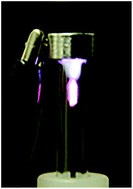Computational model of a direct current glow discharge used as an ambient desorption/ionization source for mass spectrometry
Abstract
We present a computational simulation of a helium DC glow discharge used as an ambient desorption/ionization source for mass spectrometry. Both the fluid dynamics of the flowing gases and the kinetics of the chemical reactions are modeled. The simulation incorporates measured absolute number densities of helium metastable atoms obtained using an atomic absorption spectrometer. The results indicate that the formation of protonated water cluster ions, (H2O)nH+, begins shortly downstream from the high voltage pin electrode in the active discharge region. The (H2O)nH+ ions grow in size as they flow with the helium. Several key parameters were changed to observe their effect on the formation of (H2O)nH+ ions, including the concentration of nitrogen and water impurities in the helium plasma gas, the relative humidity of the air around the discharge tube, and the air pressure. Changing impurity levels in the plasma gas had the largest effect on the formation of water clusters. Changes in ambient humidity levels affected the size of the (H2O)nH+ ions, but not the overall number of ions. Changes in air pressure did not have a significant effect.



 Please wait while we load your content...
Please wait while we load your content...